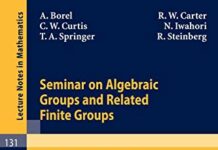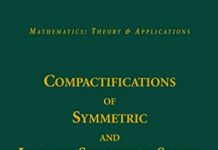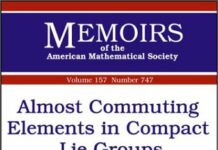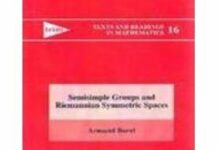
Ebook Info
- Published: 2001
- Number of pages: 184 pages
- Format: PDF
- File Size: 17.75 MB
- Authors: Armand Borel
Description
Lie groups and algebraic groups are important in many major areas of mathematics and mathematical physics. We find them in diverse roles, notably as groups of automorphisms of geometric structures, as symmetries of differential systems, or as basic tools in the theory of automorphic forms. The author looks at their development, highlighting the evolution from the almost purely local theory at the start to the global theory that we know today. Starting from Lie’s theory of local analytic transformation groups and early work on Lie algebras, he follows the process of globalization in its two main frameworks: differential geometry and topology on one hand, algebraic geometry on the other. Chapters II to IV are devoted to the former, Chapters V to VIII, to the latter.
The essays in the first part of the book survey various proofs of the full reducibility of linear representations of $mathbf{SL}_2{(mathbb{C})}$, the contributions of H. Weyl to representations and invariant theory for semisimple Lie groups, and conclude with a chapter on E. Cartan’s theory of symmetric spaces and Lie groups in the large.
The second part of the book first outlines various contributions to linear algebraic groups in the 19th century, due mainly to E. Study, E. Picard, and above all, L. Maurer. After being abandoned for nearly fifty years, the theory was revived by C. Chevalley and E. Kolchin, and then further developed by many others. This is the focus of Chapter VI. The book concludes with two chapters on the work of Chevalley on Lie groups and Lie algebras and of Kolchin on algebraic groups and the Galois theory of differential fields, which put their contributions to algebraic groups in a broader context.
Professor Borel brings a unique perspective to this study. As an important developer of some of the modern elements of both the differential geometric and the algebraic geometric sides of the theory, he has a particularly deep understanding of the underlying mathematics. His lifelong involvement and his historical research in the subject area give him a special appreciation of the story of its development.
User’s Reviews
Editorial Reviews: Review “The book under review was written by a leading contributor to the development of the theory of Lie and algebraic groups during the second half of the 20th century … Borel’s work stands out … by virtue of its genuinely scholarly nature … perceptive essays … Chapter 4 on E. Cartan’s theory of symmetric spaces is notable for its detailed analysis of Cartan’s main papers on the subject … future historians interested in the interplay of Lie groups and differential geometry will find this essay an invaluable entrée to Cartan’s mathematics … Chapter 5 … is especially notable for the new insights it provides into the work of Ludwig Maurer … many historians will benefit greatly from the expertise and insights contained in Borel’s thoughtful, carefully written essays.” —- Centaurus, International Magazine of the History of Mathematics, Science and Technology”The exposition in this book is given in a fascinating and understandable language … the book is useful for specialists as well as for people interested in the history of the development of the theory.” —- Mathematica Bohemica”The book is an essential contribution to the conmprhension of the central position taken by Lie group theory … It should be read by any perosn wanting to learn about the cultural interest of mathematics because it is written by one of the most important actors in the field …” —- Zentralblatt MATH
Reviews from Amazon users which were colected at the time this book was published on the website:
⭐Not that Armand doesn’t mention that Sophus Lie’s initial effort was to make a unified closed form solution to differential equations, but if you want to know about that mathematics, you have to go somewhere else – such as Thomas Hawkins; a book I’m hoping to get to soon enough next.Armand Borel’s book treats of Elie Cartan’s differential geometry in terms of Sophus’s Lie’s work, then Hermann Weyl’s Lie algebra work; the interplay between Lie algebra’s and Lie groups; global and local aspects. Then there’s Chevelley’s algebraic groups; algebraic groups are varieties and groups combined. Varieties are a vast generalization of the fundamental theorem of algebra due to David Hilbert. Chevelley also found the algebraic groups of E8 – the last Lie group not solved by Elie Cartan; it was recently solved by computer around 2001. Armand Borel’s book also doesn’t get into Hilber’s fifth problem about Lie groups.Coming from another direction, in the eighteen hundreds, mathematicians found invariance theory and abstract algebra through Galois’s work. In the nineteen hundreds, Emmy Noether unified both; but quickly, Lie theory in general put even Emmy Noether’s great work in (non)commutative algebra in its place in much the same way Newton/Liebniz’s calculus put algebra, trigonometry, and geometry in their places, and could solve their problems with comparable ease.I don’t know if it would be correct to consider Lie theory the ultimate mathematics of today; topology probably would stand up and be heard; but, then again they get combined with one another anyways. Overall, this book is a thrill ride and guide to much of the frontier’s of modern mathematics.
Keywords
Free Download Essays in the History of Lie Groups and Algebraic Groups (History of Mathematics, V. 21) in PDF format
Essays in the History of Lie Groups and Algebraic Groups (History of Mathematics, V. 21) PDF Free Download
Download Essays in the History of Lie Groups and Algebraic Groups (History of Mathematics, V. 21) 2001 PDF Free
Essays in the History of Lie Groups and Algebraic Groups (History of Mathematics, V. 21) 2001 PDF Free Download
Download Essays in the History of Lie Groups and Algebraic Groups (History of Mathematics, V. 21) PDF
Free Download Ebook Essays in the History of Lie Groups and Algebraic Groups (History of Mathematics, V. 21)




